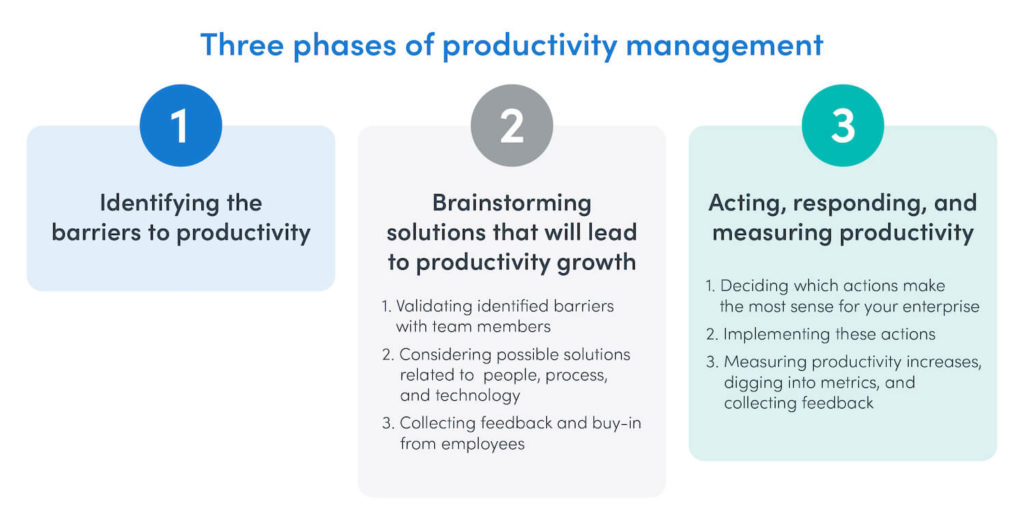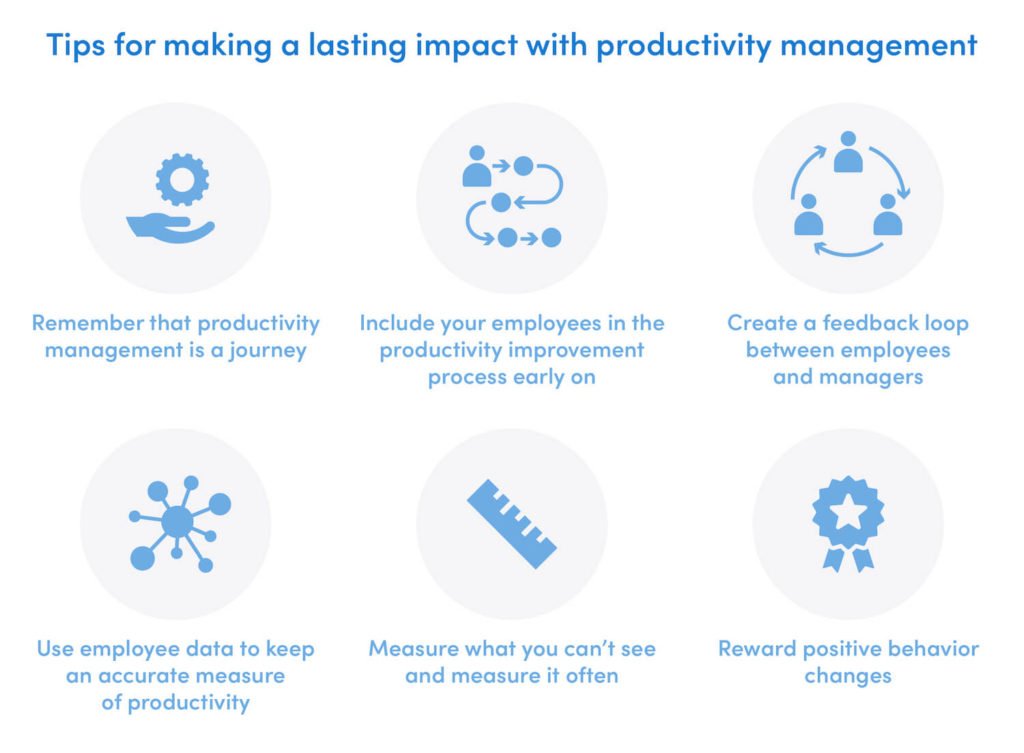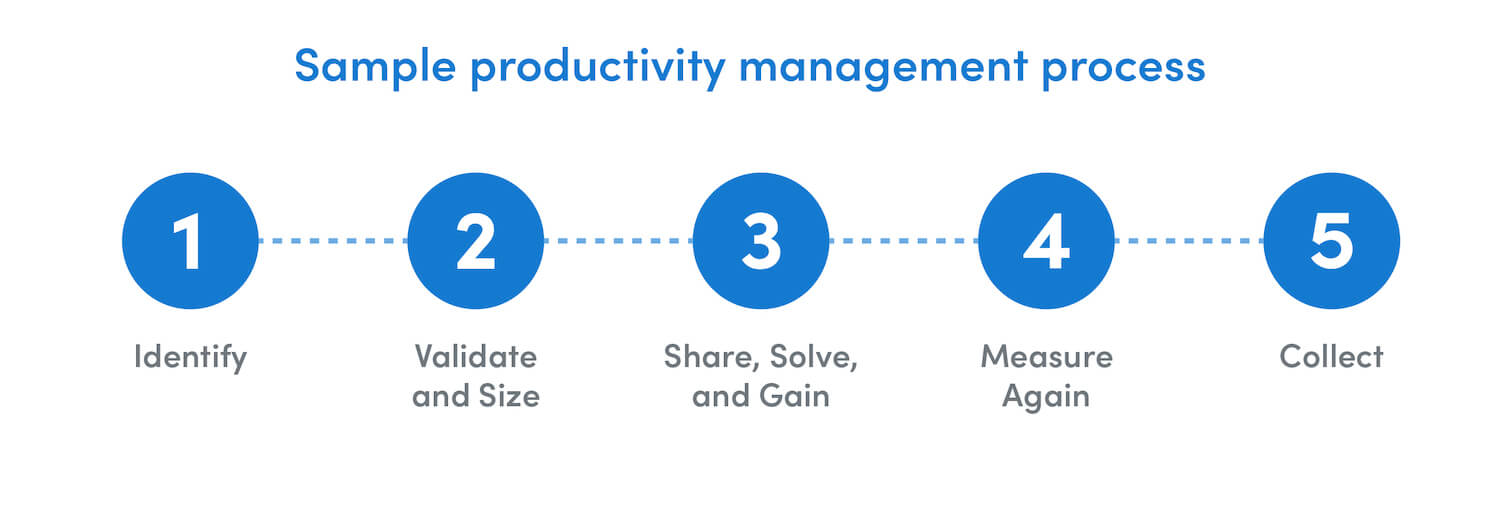Show Hide Topic Menu
- Productivity Management
- How it Works
- Learn how
- Employee Productivity:
A Modern Approach - Productivity Monitoring with Transparency
- 3 Productivity Metrics to Help Your Team Work Wiser
- Productivity Measurement at Your Company
- Tracking Productivity Through Monitoring Software
- Productivity Management for Lasting Change
- Team Productivity Through Workforce Analytics
- What Workforce Productivity Can Teach Leadership
- Productivity vs. Efficiency: Differences and Formulas
- 10 Workplace Productivity Statistics Leaders Should Know
- Employee Productivity:
Learn how to boost productivity and make changes that last by implementing actions and responses that drive positive change.
Over the last three chapters of this Productivity Management playbook, we’ve talked about why it’s important to take a modern, ethical, and data-driven approach to employee productivity. In this final chapter, we’re bringing all of these elements together and showing you how to approach productivity management in a way that lets you achieve real, lasting change that empowers your employees to do their best work.
You’ll learn how to pick the right actions to promote productivity gains and how to create a feedback loop that leads to a constant cycle of productivity improvement. Plus you’ll see how investing in quality team productivity management tools can deliver the data you need to drive that change.
Before we can start digging into how to approach productivity management, first, let’s quickly define productivity management and explain its importance.
Choose where to start:
- What is Productivity Management?
- Why is Productivity Management Important?
- Actions for Employee Productivity Management
- Three Phases of Productivity Management
- Achieving a Lasting Impact with Productivity Management
- Productivity Management and Change Management
- Tips for Making a Lasting Impact with Productivity Management
- A Sample Productivity Management Process for Keeping Employee Engagement and Overall Productivity Up
- Some Final Thoughts on Making Productivity Growth Last
What is Productivity Management?
Productivity management is a set of processes that help people and teams optimize workplace productivity and empower employees to do their best work.
At ActivTrak, we believe it’s important to take a holistic, person-driven approach to productivity management.
Why is Productivity Management Important?
Workplace productivity is vital and the key to success in any company. Effective productivity management can help organizations evaluate their team’s resources, optimize workflows, and set realistic deadlines that encourage progress. Productivity management is not just about encouraging employees to be productive for short-term gain. It’s also about the long-term too, because when you have a productive workplace, this spills over into further benefits such as higher engagement levels, greater well-being, and improved culture.
Actions for Employee Productivity Management
Let’s dig a little deeper into actions. They’re at the crux of your productivity improvement efforts and it’s natural to worry about whether or not you’re taking the right ones. The truth is that productivity management is not a one-size-fits-all endeavor, and you have to choose the actions that work best for your business and your employees. This will take some time, some research, and a lot of productivity data-driven decision-making
In some cases, you might find actions that can chip away at multiple productivity barriers. We call these “quick wins” and they should always be given priority. An example of a quick win would be implementing a new technology that will help you boost productivity by equipping them with the latest tools (a technology win!) and also helping clear bottlenecks (a process win!).
Of course, not every action covers multiple productivity barriers, and that’s ok! That doesn’t make the action any less important when it comes to productivity management. For example, if you have burnout or employee engagement issues, actions like modifying work schedules, increasing break times, or offering gym benefits can go a long way even if they’re only touching on the “people” element of the productivity trifecta.

Three Phases of Productivity Management
1. Identifying the Barriers to Productivity
Barriers to workplace productivity can lower the morale of an entire department or business. The first step is to identify specific causes that may be hindering productivity, these insights will help you support your teams as they work to achieve business goals.
2. Brainstorming Solutions that will lead to Productivity Growth
Communication is necessary for productivity management as it enables leaders and employees to work together in solving problems, brainstorming new ideas, and adapting. You should validate identified productivity barriers with your team, as this approach focuses on supporting employees and helping them succeed. This open communication helps when considering possible solutions related to your organization’s people, processes, and technology. The feedback you collect helps with getting the buy-in of your employees.
3. Acting, Responding, and Measuring Productivity
As previously mentioned, you must decide which actions make the most sense for your entire organization. After all, we believe productivity is at its best when it’s coupled with a healthy culture, engaged employees, and sustainable wellness levels. Once this is decided, you should implement actionable productivity improvements. To truly understand if improvements have been made you must continually measure productivity by digging into productivity metrics and collecting feedback.
Achieving a Lasting Impact with Productivity Management
Before we can start redefining productivity measurement, let’s circle back around to the definition of outputs and inputs again. Outputs are tangible productivity metrics we can see. They are unique to each enterprise or small business but are generally defined either as the product or service that is provided to the market or the team’s function to the larger organization. Outputs can be anything from the total number of articles published this month, to how many sales leads were generated, to how many new products were put on the market.
Inputs are intangible and harder to see. They are the behaviors and processes that directly affect your outputs. For example, if your sales team is unfocused or misaligned on strategy (inputs), that could explain why sales leads might be low this month (outputs). Unlike outputs, inputs are fairly consistent across all service industries and businesses.
The three key inputs at the core of every organization are people, processes, and technology (but more on that later).
Productivity Management and Change Management
Now that you’ve taken these actions, how do you ensure that both the actions and their responses actually stick and create real change within your organization? Productivity management and change management go hand in hand and it’s important that you incorporate processes from both in the effort to improve productivity. When preparing for change, don’t leave your team hanging. You should Identify the difficulties your employees may encounter during that change and support them through the new processes. The easiest way to ensure that updated processes are adhered to and that you’ve managed change successfully is through continuous follow-up with your team. Monitor employee productivity and keep track of successful implementation. Once new productivity management processes have been implemented, request feedback from your team on how these productivity changes can be improved in the future. This step maintains communication even after the change occurs and helps boost productivity even more going forward.
Tips for Making a Lasting Impact with Productivity Management
- Remember that productivity management is a journey — it’s not a sprint or even a marathon. You won’t get it all done in one fell swoop and that’s ok. Use targeted goal setting to stay motivated and stay on track without getting discouraged.
- Include your employees in the productivity improvement process early on to create trust and boost buy-in.
- Create a feedback loop between employees and managers to ensure that your actions are both effective and sustainable.
- Use employee data to keep an accurate measure of productivity and uncover key trends that you might not have noticed before.
- Measure what you can’t see and measure it often. The more you measure those things that you can’t see, like inputs, the more you’ll understand which actions are critical and which ones aren’t.
- Reward positive behavior changes! It’s never a bad idea to compliment someone on a job well done. A recent study found that 37% of employees feel most encouraged and motivated by personal recognition, and 84% of the most highly engaged employees in an organization received positive recognition the last time they went the extra mile at work. Be sure to check in with your team members regularly and give them a lot of positive reinforcement.

A Sample Productivity Management Process for Keeping Employee Engagement and Overall Productivity Up
All of this sounds great, but figuring out how to put it into practice can be tough. That’s why we’ve broken down everything we discussed and created this straightforward sample productivity management process for keeping your team engaged as you work to boost productivity:
1. Identify
Identify obstacles that may potentially inhibit employee performance such as work environment distractions, work-life imbalances, and ineffective project management.
2. Validate and Size
Validate and size the observations and understand the magnitude of the obstacle using your productivity data.
3. Share, Solve, and Gain
Share the findings with your team and understand in better detail what could be contributing to the obstacle. Then solve the obstacles with your team and capture any solutions they may have for improving performance. Gain commitment from employees to participate in new ways of working.
4. Measure Again
Use your productivity data again to understand the impact of the team’s solutions.
5. Collect
Finally, collect reactions from the team. If the solution was effective, ensure that it is a sustainable one. If the solution doesn’t drive productivity improvement as well as you’d hoped, devise a new one.
Some Final Thoughts on Making Productivity Growth Last
Productivity management is always a hot topic, but it has become even more relevant in light of more remote work and flexible work environments.
When it comes to improving productivity, implementing actions and responses is the most important part. The more engaged your employees are in the process, the more likely you are to succeed. Bringing your employees into the conversation early and giving them ownership over their own productivity (and their own data) is the best way to create lasting change.
As we finish this playbook, we’ll leave you with a few final pro tips for optimizing productivity management:
- Remember that improving productivity involves a continuous series of actions and responses combined with feedback and data-driven analytics.
- Wherever possible, choose combinations of actions and responses that address multiple productivity barriers to maximize your time, effort, and budget.
- Don’t forget change management! It’s key to driving successful productivity improvement across productivity enablers.

